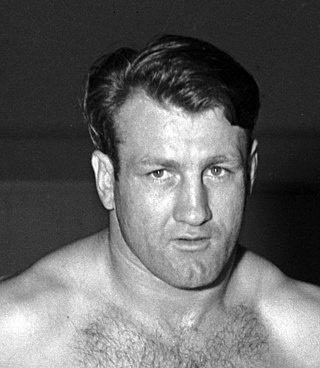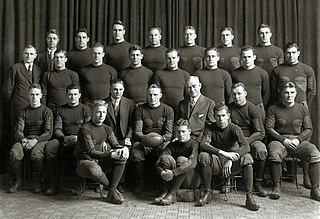Related Research Articles

Bronislau "Bronko" Nagurski was a Canadian-born professional American football fullback and offensive tackle who played in the National Football League (NFL), renowned for his strength and size. Nagurski was also a successful professional wrestler, recognized as a multiple-time World Heavyweight Champion.
The 1990 NFL season was the 71st regular season of the National Football League (NFL). To increase revenue, the league, for the first time since 1966, reinstated bye weeks, so that all NFL teams would play their 16-game schedule over a 17-week period. Furthermore, the playoff format was expanded from 10 teams to 12 teams by adding another wild card from each conference, thus adding two more contests to the postseason schedule; this format was modified with realignment in 2002 before the playoffs expanded to 14 teams in 2020.

Raymond Vincent Buivid was an American football player who played quarterback in the National Football League (NFL) for the Chicago Bears.
The 1937 NFL Championship Game was the fifth championship game of the National Football League (NFL), held December 12 at Wrigley Field in Chicago with an attendance of 15,878. The game featured the Western Division champions Chicago Bears (9–1–1) and the Eastern Division champions Washington Redskins (8–3).

The 1943 NFL Championship Game was the 11th annual title game of the National Football League (NFL), held at Wrigley Field in Chicago on December 26 with an attendance of 34,320. In a rematch of the previous year's game, the Western Division champion Chicago Bears (8–1–1) met the Eastern Division champion Washington Redskins (6–3–1). The previous week, the Redskins had defeated the New York Giants at the Polo Grounds in a playoff game by a score of 28–0 to determine the champs of the east, after the teams ended the regular season with identical records. The Redskins had dropped their final three regular season games, including two to the Giants. Even though the Giants had swept the season series with Washington, the rules of the time called for a tiebreaker game.
The 1930 season was the Chicago Bears' 11th in the National Football League. The team was able to improve on their 4–9–2 record from 1929 and finished with a 9–4–1 record under first-year head coach Ralph Jones. Jones, a former player, led the team to recover from its ninth-place finish to a respectable third-place finish. The season started badly with a 1–2–1 record over the first four games, the only win coming against the hapless Minneapolis Redjackets. After splitting games five and six, the Bears got their winning ways back, finishing the season with 5 straight wins and 7 wins in their last 8 games. The only loss those last 8 games was to eventual champion Green Bay. The secret to the Bears' success was new talent in the backfield. All-American and rookie Bronko Nagurski starred at fullback while living legend Red Grange starred at tailback. These two future Hall of Famers combined for 13 touchdowns overall. Luke Johnsos, in his second year, also starred at the end. The makings of future championships were in place.
The 1931 season was the Chicago Bears' 12th in the National Football League. The team was unable to improve on their 9–4–1 record from 1930 and finished with an 8–5 record under sophomore head coach Ralph Jones. The club finished in third place once again behind the Green Bay Packers and the Portsmouth Spartans. The Bears opened the season well, winning three of their first four games, including victories over the Cardinals and Giants. Chicago then dropped two in a row, both at home to the Packers and Yellowjackets. Four consecutive wins in the middle of the season put the Bears back in contention; however, another weak ending, losing two of their last three, made the season somewhat of a disappointment. Grange and Nagurski again carried the team, with 9 touchdowns between them. The Bears' biggest weakness was an aging interior line, with few young linemen joining the team who had an impact. They also lacked a consistent kicking game, now that Paddy Driscoll and the Sternaman brothers had all retired. Owner George Halas would remedy these problems over the next few years and get the Bears back on top.

The 1932 season was the Chicago Bears' 13th in the National Football League. The team was able to improve on their 9–4–1 record from 1931 and finished with a 7–1–6 record under third-year head coach Ralph Jones.
The 1943 season was the Chicago Bears' 24th in the National Football League. The team failed to match on their 11–0 record from 1942 and finished at 8–1–1, under temporary co-coaches Hunk Anderson and Luke Johnsos. On the way to winning the Western Division, the Bears were, yet again, denied a chance at an undefeated season by the defending champion Redskins in Washington. The Bears had their revenge in the NFL title game and defeated the Redskins at Wrigley Field to claim their sixth league title. It was their third championship in four years, establishing themselves as the pro football dynasty of the early 1940s.
The 1933 season was the Chicago Bears' 14th in the National Football League and the 11th season under head coach George Halas. The team was able to improve on their 7–1–6 record from 1932 and finished with a 10–2–1 record.
The 1934 season was the Chicago Bears' 15th in the National Football League and 12th season under head coach George Halas. The team was able to improve on their 10–2–1 record from 1933 and finished with an undefeated 13–0 record.
The 1935 season was the Chicago Bears' 16th in the National Football League and 13th season under head coach George Halas. The team was unable to match on their 13–0 record from 1934 and finished with a 6–4–2 record and finishing in a tie for third place in the Western Division, and failed to return to the championship game. The Bears had little trouble with the weaker teams in the league, led the league in scoring, and occasionally showed signs of brilliance against top-flight competition, but for the most part, they were outclassed by the Lions, Packers, and Giants. The biggest problem was the veterans from the 1920s had largely retired or were past their prime but not enough young talent had emerged to offset these losses. In particular, the retirement of Link Lyman and Red Grange hurt the team, especially on defense. Additionally, Bronko Nagurski and Bill Hewitt were injured for large portions of the season and could not play to their normal level.
The 1936 season was the Chicago Bears' 17th in the National Football League and 14th season under head coach George Halas. The team was able to improve on their 6–4–2 record from 1935 and finished with a 9–3 record. The team also finished in second place in the Western Division behind the Green Bay Packers. After week 10, the Bears were tied with the Packers in first place with identical 9–1 records, having split their season series. However, the club swooned at the end of the year, losing their last two games on the road to Detroit and the Cardinals. Green Bay went on to easily defeat the Boston Redskins and win the NFL title.
The 1937 Chicago Bears season was their 18th regular season completed in the National Football League. The Bears started the season fast, winning their first five games, three of them on the road. After a tie to the Giants and a loss to the Packers, the Bears finished the season strong, winning their last four games. The team was second in scoring offense, behind Green Bay, and led the league in scoring defense.
The 1939 Chicago Bears season was their 20th regular season completed in the National Football League. They finished second in the Western Division with an 8–3 record. The Bears started the season well, winning 4 of their first 5 games. However, two mid-season losses to New York and Detroit cost them the Division to Green Bay. The Packers went on to win the NFL championship.

A fullback (FB) is a position in the offensive backfield in gridiron football and is one of the two running back positions along with the halfback. Fullbacks are typically larger than halfbacks, and, in most offensive schemes, the fullback's duties are split among power running, pass catching, and blocking for both the quarterback and the other running back.
The 1934 Detroit Lions season was the fifth in franchise history and the first in Detroit; the franchise had previously played as the Portsmouth Spartans in Portsmouth, Ohio, a city with a population of approximately 40,000. Under head coach Potsy Clark, the Lions won their first ten games then lost three straight in an eight-day span to end the season at 10–3. They finished in second place in the NFL Western Division, three games behind the undefeated Chicago Bears.
The 1920 Detroit Heralds season was the 16th season for the Detroit Heralds, an independent American football team. Led by coach Bill Marshall, the team compiled a 2–3–3 record. The 1920 season was the team's first competing in the new American Professional Football Association. The team finished in ninth place in the league.
The 1944 Michigan Wolverines football team represented the University of Michigan in the 1944 Big Ten Conference football season. Under seventh-year head coach Fritz Crisler, Michigan compiled a record of 8–2, outscored opponents 204 to 91, finished in second place in the Big Ten Conference, and was ranked #8 in the final AP Poll. The team opened the season with a victory over an Iowa-Pre-Flight team that won all of its remaining games and ended the season ranked #6 in the final AP Poll. The Wolverines then shut out four opponents: Marquette (14-0); Northwestern (27-0); Illinois (14-0); and Wisconsin (14-0). The team's two losses came against Indiana and an undefeated Ohio State team that was ranked #2 in the final AP Poll.

The 1929 Michigan Wolverines football team was an American football team that represented the University of Michigan in the 1929 Big Ten Conference football season. The team compiled a 5–3–1 record, tied for seventh place in the Big Ten, and outscored its opponents by a total of 109 to 75. In late May 1929, Tad Wieman was removed as the team's head coach. Harry Kipke was hired as his replacement in mid-June; Kipke remained as Michigan's head football coach for nine seasons.
References
- ↑ Strickler, George (September 24, 1938). "Bears Roll Up 51 Points and Stars Get None". Chicago Tribune . p. 17. Retrieved August 20, 2023– via newspapers.com.